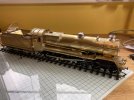So onwards and upwards.
The loco frames were almost straightforward. I decided that I would include some give in the centre axle in the same way that I did for the tender frames. It is quite a long wheelbase for a small loco. That worked out quite well, but raised the question of how to joint the coupling rods. On the J21 the frames I built had a rigid base with solid coupling rods, but it developed a problem and didn't run particularly well, so Paul Moore made another one for me. I forgot to ask him if the rods are solid or not. Anyway, on the J25 the coupling rods on the centre axle are each a half thickness etch with a dummy joint forward. If I put a pin in the dummy joint the rods will try to pivot at the joint and the crankpin. I don't think that will work, so for now the rods are not secured together and it is running as a pair of 0-4-0's sharing a common axle. It seems to work but I have something in my failing memory banks that says it is not a good idea to do this. Any advice?
That isn't quite the whole story for the rods. The kit is now rather old and while some modifications have been done over the years, I think the frame etch is an original hand drawn job. I would normally build the rods first and use them to check the axle spacing but for some strange reason I didn't do that this time. It is always a crossed finger moment when you see if it rolls with the rods on first time. Well it didn't. It would run freely as an 0-4-0 with rear and centre wheels connected, and even when the front left hand side rod was added, but the addition of the front right hand rod caused a lock up at forward and rear centres. The rod is perhaps about half a mil too short but by slowly elongating the leading hole I got it to run freely.
One other problem was found. I fitted the cross wires for the top of the brake hangars but they then were at a strange angle to the wheel. I redrilled the holes about 2mm closer to the wheels and that did the trick. I wonder if this is a hangover from the common ancestry with the J21. Although the frames for each are different the kits share the same body etches with additional parts for the J21, (but using the same brakes for both and the hangars are too small for the larger wheeled J21). So I have it in mind to have the two kits redrawn. They will still be able to share many parts but really need their own etches.
I did my usual trick of making a torque reacting bracket from scrap etch. This secures the ABC mini and Maxon motor in place. I will clean up teh wheels just before I return to UK or they will rust like crazy here. The axles are well oiled to keep them safe.


Next job is to toss a coin and see if it is loco or tender body next.


































